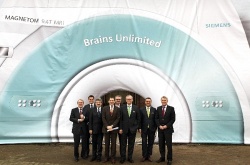MRI - Aiming to crack the human brain code
The Netherlands - In a very crowded train station, why can you immediately recognise the face of a friend? Professor Rainer Goebel wants to find out. Thanks to €10 million in funding from the country’s Limburg Province, the Brains Unlimited project at Maastricht University will install three high-field magnetic resonance imaging scanners that will allow Prof. Goebel to search for an answer.
By John Brosky


‘It is now known that the brain is organised in many specialised brain areas, such as the fusiform face area that responds almost only to faces,’ he explained. ‘But it’s not yet known how the brain codes a face. For example, are there neuronal populations coding for eyes, nose, hair and mouth?’
High-field MRI scanning beyond 7-tesla (7-T) achieves functional resolution at the sub-millimetre level where, he said, his studies show neurons with similar response properties appear to spatially cluster into functional units or cortical columns.
‘It’s my belief,’ he confirmed, ‘that, with a massive attempt to crack the columnar-level code in as many areas as possible, we’ll ultimately reach a deeper understanding how mind emerges from simpler units in the brain.’
Another research project at Brains Unlimited will explore the structure of musicians’ ears to learn why they can hear so differently from those of other people. ‘The ultra-high magnetic fields scanners will allow us to view the anatomy and function of the brain in vivo, with a much higher level of detail,’ said Prof. Goebel, who in January 2011 received a €2.5 million grant from the European Research Council (ERC) for his study into the functional organisation of the human brain.
In funding the three new whole body scanners from Siemens Healthcare, Limburg Province hopes ‘to open doors to biomedical research areas for anatomy, cardiovascular, oncology and pharmacology’.
The Limburg council also has its eye on economic development, believing an excellence centre in high-field MRI, such as Vienna recently created, can be an engine for job growth.
The project also received funding from the EU and the Municipality of Maastricht. At Brains Unlimited, the new MRI infrastructure creates a versatile and powerful research tool with intertwined functions, according to the province council. To be housed in a special facility at the University’s Faculty of Psychology and Neurosciences, the Siemens MRIs cover a range from 3-T to 7-T to a state-of-the-art 9.4-T scanner.
Siemens manufactures the only 9.4-T MRI approved for human imaging in a hospital setting. MRIs of this scale, currently used at university centres, tend to be smaller bore scanners for animal studies, a company spokesman explained.
The 3-T scanner at the Maastricht campus will be used for routine diagnostic imaging as well as for commercial applications in MRI technology development.
BrainVoyager, developed by Dr Goebel, is an example of a cross-platform neuro-imaging software package for the analysis and visualisation of functional and structural MRI data sets. He also created the Brain Tutor 3-D application for iPhone and the Brain Tutor High Definition application for the iPad.
High-end research on the new high-field 7-T and 9.4-T scanners will be applied to explorations into the causes of multiple sclerosis, Alzheimer’s, Parkinson’s, epilepsy, and tumour growth.
20.04.2011











